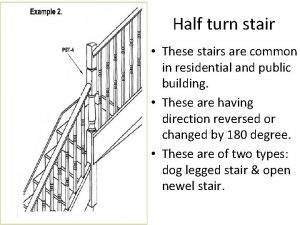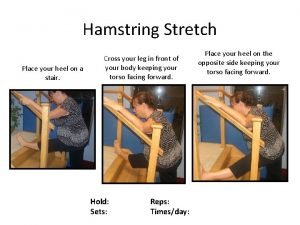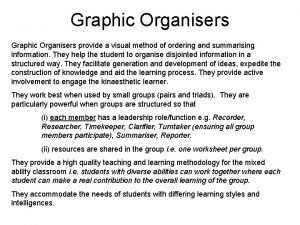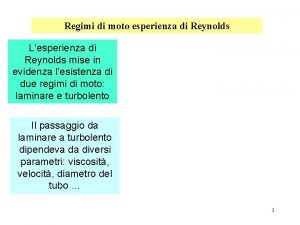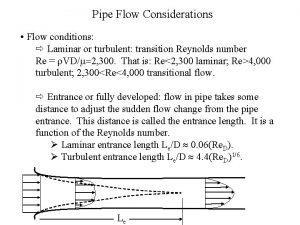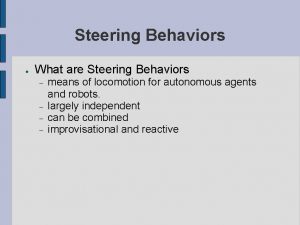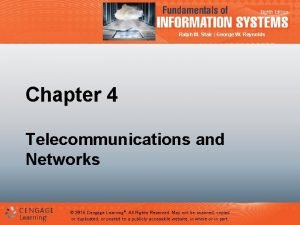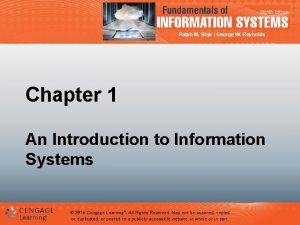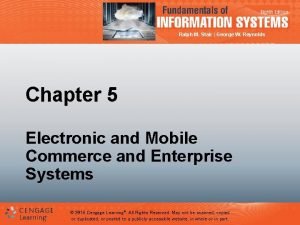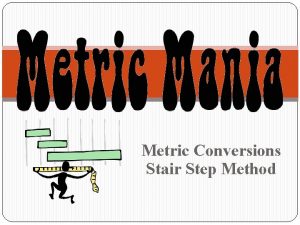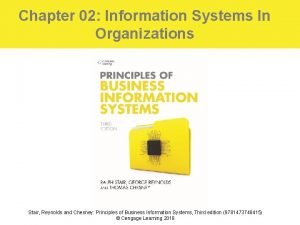Ralph M Stair George W Reynolds Chapter 12





















































































- Slides: 85

Ralph M. Stair | George W. Reynolds Chapter 12 Systems Development: Investigation, Analysis, and Design © 2016 Cengage Learning®. All Rights Reserved. May not be scanned, copied or duplicated, or posted to a publicly accessible website, in whole or in part.

Principles and Learning Objectives: Key Participants • Effective systems development requires a team effort from stakeholders, users, managers, systems development specialists, and various support personnel, and it starts with building an information systems plan – Identify the key participants in the systems development process and discuss their roles in ensuring project success © 2016 Cengage Learning®. All Rights Reserved. May not be scanned, copied or duplicated, or posted to a publicly accessible website, in whole or in part. 2

Principles and Learning Objectives: Importance of Information Systems • Effective systems development requires a team effort from stakeholders, users, managers, systems development specialists, and various support personnel, and it starts with building an information systems plan – Discuss the importance of information systems planning and outline the steps of this process © 2016 Cengage Learning®. All Rights Reserved. May not be scanned, copied or duplicated, or posted to a publicly accessible website, in whole or in part. 3

Principles and Learning Objectives: Systems Investigation • Systems investigation is needed to gain a clear understanding of the specifics of the problem to be solved or the opportunity to be addressed and to determine if the opportunity is worth pursuing – Outline the steps associated with systems investigation – Discuss some of the tools and techniques used in this phase of systems development © 2016 Cengage Learning®. All Rights Reserved. May not be scanned, copied or duplicated, or posted to a publicly accessible website, in whole or in part. 4

Principles and Learning Objectives: Feasibility Analysis • Systems investigation is needed to gain a clear understanding of the specifics of the problem to be solved or the opportunity to be addressed and to determine if the opportunity is worth pursuing – Define feasibility analysis and describe technical, economic, legal, operational, and schedule feasibility © 2016 Cengage Learning®. All Rights Reserved. May not be scanned, copied or duplicated, or posted to a publicly accessible website, in whole or in part. 5

Principles and Learning Objectives: Systems Analysis • Systems analysis is needed to define what the information system must do to solve the problem – Outline the steps associated with systems analysis – Discuss some of the tools and techniques used in this phase of systems development © 2016 Cengage Learning®. All Rights Reserved. May not be scanned, copied or duplicated, or posted to a publicly accessible website, in whole or in part. 6

Principles and Learning Objectives: Make-versus-Buy • Systems analysis is needed to define what the information system must do to solve the problem – Discuss the importance of the make-versusbuy decision and outline a process for performing this activity © 2016 Cengage Learning®. All Rights Reserved. May not be scanned, copied or duplicated, or posted to a publicly accessible website, in whole or in part. 7

Principles and Learning Objectives: Systems Design • Systems design is needed to define exactly how the information system will solve a problem – Outline the steps associated with systems design – Discuss some of the tools and techniques used in this phase of systems development © 2016 Cengage Learning®. All Rights Reserved. May not be scanned, copied or duplicated, or posted to a publicly accessible website, in whole or in part. 8

Why Learn About Systems Investigation, Analysis, and Design? • Information systems are used in a variety of careers • Learning how to acquire information systems or how to have them developed can help you in your career © 2016 Cengage Learning®. All Rights Reserved. May not be scanned, copied or duplicated, or posted to a publicly accessible website, in whole or in part. 9

An Overview of Systems Development • Managers and employees in all functional areas work together and use business information systems • Corporations and nonprofit organizations use the systems development process to build information systems to achieve their goals © 2016 Cengage Learning®. All Rights Reserved. May not be scanned, copied or duplicated, or posted to a publicly accessible website, in whole or in part. 10

Participants in Systems Development • The development team: – Consists of stakeholders, users, managers, systems development specialists, and various support personnel – Determines information system’s objectives – Delivers a system that meets objectives © 2016 Cengage Learning®. All Rights Reserved. May not be scanned, copied or duplicated, or posted to a publicly accessible website, in whole or in part. 11

Participants in Systems Development: The Development Team • Project manager: the person assigned by the organization to do the work of the project and achieve the project objectives • Stakeholders: people who ultimately will be affected (for better or worse) by the systems development project • Users: people who will regularly interact with the system © 2016 Cengage Learning®. All Rights Reserved. May not be scanned, copied or duplicated, or posted to a publicly accessible website, in whole or in part. 12

Participants in Systems Development: The Development Team (cont’d. ) • Systems analysts: specializes in analyzing and designing business systems • Programmer: responsible for modifying or developing programs to satisfy user requirements © 2016 Cengage Learning®. All Rights Reserved. May not be scanned, copied or duplicated, or posted to a publicly accessible website, in whole or in part. 13

Role of the Project Manager © 2016 Cengage Learning®. All Rights Reserved. May not be scanned, copied or duplicated, or posted to a publicly accessible website, in whole or in part. 14

Systems Development: Others Directly Involved • Steering team – A small group of senior managers representing the business and IS organizations that provide guidance and support to the project • Project sponsor – A key member and leader of the steering team who plays such a critical role that lack of this essential individual raises the distinct probability of project failure © 2016 Cengage Learning®. All Rights Reserved. May not be scanned, copied or duplicated, or posted to a publicly accessible website, in whole or in part. 15

Information Systems Planning • Identifies those information systems development initiatives needed to support organizational strategic goals • An organization’s goals define a system’s objectives – Critical success factors (CSFs): factors that are essential to the success of a functional area of an organization © 2016 Cengage Learning®. All Rights Reserved. May not be scanned, copied or duplicated, or posted to a publicly accessible website, in whole or in part. 16

Information Systems Planning (cont’d. ) © 2016 Cengage Learning®. All Rights Reserved. May not be scanned, copied or duplicated, or posted to a publicly accessible website, in whole or in part. 17

Steps of Information Systems Planning © 2016 Cengage Learning®. All Rights Reserved. May not be scanned, copied or duplicated, or posted to a publicly accessible website, in whole or in part. 18

Steps of Information Systems Planning (cont’d. ) © 2016 Cengage Learning®. All Rights Reserved. May not be scanned, copied or duplicated, or posted to a publicly accessible website, in whole or in part. 19

Initiating Systems Development • Systems development initiatives: – Arise from all levels of an organization – Can be planned or unplanned – Can take advantage of new technologies • Mergers and acquisitions can trigger many systems development projects © 2016 Cengage Learning®. All Rights Reserved. May not be scanned, copied or duplicated, or posted to a publicly accessible website, in whole or in part. 20

Traditional Systems Development Life Cycle • Also called a systems development life cycle (SDLC) • A sequential multistage process where work on the next stage cannot begin until the results of the previous stage are reviewed and approved or modified as necessary © 2016 Cengage Learning®. All Rights Reserved. May not be scanned, copied or duplicated, or posted to a publicly accessible website, in whole or in part. 21

Traditional Systems Development Life Cycle (cont’d. ) © 2016 Cengage Learning®. All Rights Reserved. May not be scanned, copied or duplicated, or posted to a publicly accessible website, in whole or in part. 22

Table 12. 1 Advantages and Disadvantages of Traditional SDLC Advantages Disadvantages Formal review at the end of each phase allows maximum management control. Users get a system that meets the needs as understood by the developers; this might not be what the users really needed. This approach requires creation of considerable system documentation. Documentation is expensive and time consuming to create. It is also difficult to keep current. Often, user needs go unstated or are miscommunicated or misunderstood. Formal documentation ensures that system requirements can be traced back to stated business needs. Approach produces many intermediate products that can be reviewed to see whether they meet the users’ needs and conform to standards. Users can’t easily review intermediate products and evaluate whether a particular product (e. g. , a data-flow diagram) meets their business requirements. © 2016 Cengage Learning®. All Rights Reserved. May not be scanned, copied or duplicated, or posted to a publicly accessible website, in whole or in part. 23

Systems Investigation • Steps of the investigation phase 1. Review systems investigation request 2. Identify and recruit team leader and team members 3. Develop budget and schedule for investigation 4. Perform investigation © 2016 Cengage Learning®. All Rights Reserved. May not be scanned, copied or duplicated, or posted to a publicly accessible website, in whole or in part. 24

Steps of the Investigation Phase (cont’d. ) 5. Perform preliminary feasibility analysis 6. Prepare draft of investigation report 7. Review results of investigation with steering team © 2016 Cengage Learning®. All Rights Reserved. May not be scanned, copied or duplicated, or posted to a publicly accessible website, in whole or in part. 25

Investigation Phase: Review Systems Investigation Request • A systems investigation request includes: – A preliminary statement of the problem or opportunity to be addressed – A brief discussion of how this effort aligns with previously defined company and organization objectives, goals, and strategies – Identification of the general areas of the business and business processes to be included in the scope of the study © 2016 Cengage Learning®. All Rights Reserved. May not be scanned, copied or duplicated, or posted to a publicly accessible website, in whole or in part. 26

Investigation Phase: Identify and Recruit Team Leader and Team Members • A leader is identified and recruited after managers grant approval to initiate systems investigation • Investigation team members chosen next • Investigation team responsibilities – Gather and analyze data – Prepare an investigation phase report – Present results to the project steering team © 2016 Cengage Learning®. All Rights Reserved. May not be scanned, copied or duplicated, or posted to a publicly accessible website, in whole or in part. 27

Develop Budget and Schedule for Investigation • The team develops a list of specific objectives and activities to accomplish along with a schedule for completing the work • The team establishes major milestones to help monitor progress • A budget is prepared including travel expenses and funds for consultants © 2016 Cengage Learning®. All Rights Reserved. May not be scanned, copied or duplicated, or posted to a publicly accessible website, in whole or in part. 28

Investigation Phase: Perform Investigation • Refine the initial problem definition and scope described in the systems investigation request • Identify the high-level business requirements the system must meet • Identify any issues or risks associated with the project © 2016 Cengage Learning®. All Rights Reserved. May not be scanned, copied or duplicated, or posted to a publicly accessible website, in whole or in part. 29

Perform Investigation: Joint Application Development (JAD) • A structured meeting process that can accelerate and improve the efficiency and effectiveness of the investigation, analysis, and design phases of a systems development project © 2016 Cengage Learning®. All Rights Reserved. May not be scanned, copied or duplicated, or posted to a publicly accessible website, in whole or in part. 30

Table 12. 2 JAD Participants and Their Role Facilitator Responsibilities ● Determines JAD session objectives ● Plans JAD session to meet objectives ● Leads JAD session ● Encourages everyone to participate Qualifications ● Excellent meeting facilitator ● Unbiased and does not take sides Decision makers ● Resolve ● Stakeholders Users ● Describe conflicts ● Avoid gridlock business as it is and as it should be ● Provide business expertise ● Define problems, identify potential benefits, analyze existing system, define requirements of a new system, and propose and evaluate possible solutions selected by project sponsor to make decisions ● Have the authority and willingness to make decisions ● Represent all major areas affected ● Expert in their area of the business © 2016 Cengage Learning®. All Rights Reserved. May not be scanned, copied or duplicated, or posted to a publicly accessible website, in whole or in part. 31

Table 12. 2 JAD Participants and Their Role (cont’d. ) Role System developer s Scribe Responsibilities ● Observe carefully ● Offer technical opinion on cost or feasibility, if requested ● Gain deep understanding of customers’ needs and desires ● Participate in discussion to clarify points and capture them accurately ● Document key points, issues, next steps, and decisions throughout the JAD session ● Publish results of JAD session and solicit feedback Qualifications ● Member of system development team ● Excellent listening skills ● Experience in using software engineering tools to document requirements and create system models © 2016 Cengage Learning®. All Rights Reserved. May not be scanned, copied or duplicated, or posted to a publicly accessible website, in whole or in part. 32

Perform Investigation: Functional Decomposition • A technique used during the investigation, analysis, and design phases to define the business processes included within the scope of the system • Create a functional decomposition chart – Begin with the name of a system – Identify the highest-level processes and assign a “verb-subject” name to each process – Break down to three to four subprocess levels © 2016 Cengage Learning®. All Rights Reserved. May not be scanned, copied or duplicated, or posted to a publicly accessible website, in whole or in part. 33

Functional Decomposition Chart © 2016 Cengage Learning®. All Rights Reserved. May not be scanned, copied or duplicated, or posted to a publicly accessible website, in whole or in part. 34

Investigation Phase: Perform Preliminary Feasibility Analysis • Components of the feasibility analysis – Technical feasibility – Economic feasibility – Legal feasibility – Operational feasibility – Schedule feasibility © 2016 Cengage Learning®. All Rights Reserved. May not be scanned, copied or duplicated, or posted to a publicly accessible website, in whole or in part. 35

Investigation Phase: Prepare Draft of Investigation Report • A systems investigation report that summarizes the results of the systems investigation and recommends a course of action • Possible actions – Continue on into systems analysis – Modify the project in some manner and perhaps repeat the systems investigation – Drop the project altogether © 2016 Cengage Learning®. All Rights Reserved. May not be scanned, copied or duplicated, or posted to a publicly accessible website, in whole or in part. 36

Table of Contents for Systems Investigation Report © 2016 Cengage Learning®. All Rights Reserved. May not be scanned, copied or duplicated, or posted to a publicly accessible website, in whole or in part. 37

Investigation Phase: Review Results of Investigation with Steering Team • The systems investigation report is reviewed with the steering team to gain their input and counsel • Input is used to finalize the systems investigation report © 2016 Cengage Learning®. All Rights Reserved. May not be scanned, copied or duplicated, or posted to a publicly accessible website, in whole or in part. 38

Systems Analysis Steps in the systems analysis phase 1. Identify and recruit team leader and team members 2. Develop budget and schedule for systems analysis activities 3. Study existing system 4. Develop prioritized set of requirements © 2016 Cengage Learning®. All Rights Reserved. May not be scanned, copied or duplicated, or posted to a publicly accessible website, in whole or in part. 39

Steps in the Systems Analysis Phase (cont’d. ) 5. Perform preliminary make-versus-buy analysis 6. Identify and evaluate alternative solutions 7. Perform feasibility analysis 8. Prepare draft of systems analysis report 9. Review results of systems analysis with steering team © 2016 Cengage Learning®. All Rights Reserved. May not be scanned, copied or duplicated, or posted to a publicly accessible website, in whole or in part. 40

Systems Analysis Phase: Identify and Recruit Team Leader and Team Members • Some members of the original investigation team participating in the systems analysis provide project continuity © 2016 Cengage Learning®. All Rights Reserved. May not be scanned, copied or duplicated, or posted to a publicly accessible website, in whole or in part. 41

Develop Budget and Schedule for Systems Analysis Activities • The team develops a list of specific objectives and activities required to complete the systems analysis is developed along with a schedule • The team establishes major milestones to track progress • A budget is prepared including travel expenses and funds for outside resources © 2016 Cengage Learning®. All Rights Reserved. May not be scanned, copied or duplicated, or posted to a publicly accessible website, in whole or in part. 42

Systems Analysis Phase: Study Existing System • Identify the strengths and weaknesses of the existing system • Examine current inputs, outputs, processes, security and controls, and system performance • Data collection methods – Direct observation – Surveys © 2016 Cengage Learning®. All Rights Reserved. May not be scanned, copied or duplicated, or posted to a publicly accessible website, in whole or in part. 43

Internal and External Sources of Data for Systems Analysis © 2016 Cengage Learning®. All Rights Reserved. May not be scanned, copied or duplicated, or posted to a publicly accessible website, in whole or in part. 44

System Analysis: Develop Prioritized Set of Requirements • Priority categories – Critical – Medium priority – Low priority • JAD sessions provide an effective way to define system requirements – Ask managers to produce a list of CSFs © 2016 Cengage Learning®. All Rights Reserved. May not be scanned, copied or duplicated, or posted to a publicly accessible website, in whole or in part. 45

Defining System Requirements © 2016 Cengage Learning®. All Rights Reserved. May not be scanned, copied or duplicated, or posted to a publicly accessible website, in whole or in part. 46

Prioritized Set of Requirements: Using the Identified CSFs • Processes must be further defined and individuals/organizations responsible for process steps identified • Data-flow diagrams (DFDs) provide a model of a proposed new system © 2016 Cengage Learning®. All Rights Reserved. May not be scanned, copied or duplicated, or posted to a publicly accessible website, in whole or in part. 47

Data Flow Diagram © 2016 Cengage Learning®. All Rights Reserved. May not be scanned, copied or duplicated, or posted to a publicly accessible website, in whole or in part. 48

Prioritized Set of Requirements: Databases and ER Diagrams • Data modeling defines: – Databases the system will draw from – New databases the system will create • Entity-relationship (ER) diagrams show logical relationships among data entities • Computer-aided software engineering (CASE) can help describe the existing system © 2016 Cengage Learning®. All Rights Reserved. May not be scanned, copied or duplicated, or posted to a publicly accessible website, in whole or in part. 49

Entity-Relationship (ER) Diagram for a Customer Order Database © 2016 Cengage Learning®. All Rights Reserved. May not be scanned, copied or duplicated, or posted to a publicly accessible website, in whole or in part. 50

Context for New System Security And Control Requirements © 2016 Cengage Learning®. All Rights Reserved. May not be scanned, copied or duplicated, or posted to a publicly accessible website, in whole or in part. 51

Prioritized Set of Requirements: System Performance • Factors in determining system performance – Timeliness of output – Ease of use – Scalability – System response time – Availability – Reliability © 2016 Cengage Learning®. All Rights Reserved. May not be scanned, copied or duplicated, or posted to a publicly accessible website, in whole or in part. 52

Systems Analysis Phase: Perform Preliminary Make-Versus-Buy Analysis • Make-versus-buy decision: the decision regarding whether to obtain the necessary software from internal or external sources • Request for proposal (RFP) – The primary tool for assessing assess the software marketplace to determine whether existing packages can meet the organization’s needs © 2016 Cengage Learning®. All Rights Reserved. May not be scanned, copied or duplicated, or posted to a publicly accessible website, in whole or in part. 53

Relative Cost of Custom Software © 2016 Cengage Learning®. All Rights Reserved. May not be scanned, copied or duplicated, or posted to a publicly accessible website, in whole or in part. 54

Table 12. 4 Comparison of Developed and Off-the-Shelf Software Factor Cost Develop (Make) Off-the-Shelf (Buy) The cost to build the system can be difficult to estimate accurately and is frequently higher than offthe-shelf Custom software is more likely to satisfy your needs The true cost to implement an off-the-shelf solution is also difficult to estimate accurately but is likely to be less than a custom software solution Might not get exactly what you need Tend to automate existing business processes even if they are poor Quality can vary depending on the development team Adoption of a package may simplify or streamline a poor existing business process Can assess the quality before buying Speed Can take years to develop Can acquire it now Staffing and support Requires in-house skilled resources to build and support a custom-built solution Can develop a competitive advantage with good software Requires paying the vendor for support Needs Process improvement Quality Competitive advantage Other organizations can have the same software and same advantage © 2016 Cengage Learning®. All Rights Reserved. May not be scanned, copied 55 or duplicated, or posted to a publicly accessible website, in whole or in part.

Recommended Table of Contents for a Request for Proposal © 2016 Cengage Learning®. All Rights Reserved. May not be scanned, copied or duplicated, or posted to a publicly accessible website, in whole or in part. 56

Systems Analysis Phase: Identify and Evaluate Alternative Solutions • The analysis team must think creatively and consider several system solution options • Pareto principle (80– 20 rule): An observation that for many events, roughly 80 percent of the effects come from 20 percent of the causes © 2016 Cengage Learning®. All Rights Reserved. May not be scanned, copied or duplicated, or posted to a publicly accessible website, in whole or in part. 57

Table 12. 5 Additional Candidates for Systems Analysis Scope of system Build system that meets all critical requirements, but no medium or low priority requirements Modify package so that it meets all critical requirements, but no medium or low priority requirements Build system that meets 20% of all requirements that will provide 80% of the system benefits Build system Option #1 Customize software package Option #2 Option #3 Modify package so that it meets 20% of all requirements that will provide 80% of the system benefits Implement software package just as is with no customization to enable it to meet unique requirements © 2016 Cengage Learning®. All Rights Reserved. May not be scanned, copied or duplicated, or posted to a publicly accessible website, in whole or in part. Option #4 Option #5 58

System Analysis Phase: Perform Feasibility Analysis • An in-depth feasibility analysis is done for each of the candidate solutions the team wants to consider © 2016 Cengage Learning®. All Rights Reserved. May not be scanned, copied or duplicated, or posted to a publicly accessible website, in whole or in part. 59

System Analysis Phase: Prepare Draft of Systems Analysis Report • Systems analysis concludes with a formal systems analysis report summarizing the findings of this phase of the project © 2016 Cengage Learning®. All Rights Reserved. May not be scanned, copied or duplicated, or posted to a publicly accessible website, in whole or in part. 60

Typical Table of Contents for a Report on an Existing System © 2016 Cengage Learning®. All Rights Reserved. May not be scanned, copied or duplicated, or posted to a publicly accessible website, in whole or in part. 61

Systems Analysis: Review Results of Systems Analysis with Steering Team • The systems analysis report is presented to the project steering team with a recommendation to stop, revise, or go forward with the systems development project • The project sponsor and the steering team must formally approve of any changes © 2016 Cengage Learning®. All Rights Reserved. May not be scanned, copied or duplicated, or posted to a publicly accessible website, in whole or in part. 62

Systems Design Steps in the systems design phase 1. Identify and recruit team leader and team members 2. Develop schedule and budget for systems design activities 3. Design user interface 4. Design system security and controls 5. Design disaster recovery plan © 2016 Cengage Learning®. All Rights Reserved. May not be scanned, copied or duplicated, or posted to a publicly accessible website, in whole or in part. 63

Steps in the Systems Design Phase (cont’d. ) 6. 7. 8. 9. Design database Perform feasibility analysis Prepare draft of systems design report Review results of systems design with steering team 10. Finalize contract © 2016 Cengage Learning®. All Rights Reserved. May not be scanned, copied or duplicated, or posted to a publicly accessible website, in whole or in part. 64

Design Phase: Identify and Recruit Team Leader and Team Members • Some members of the systems analysis team participating in the systems design ensure project continuity © 2016 Cengage Learning®. All Rights Reserved. May not be scanned, copied or duplicated, or posted to a publicly accessible website, in whole or in part. 65

Design Phase: Develop Schedule and Budget for Systems Design Activities • The systems design team develops a list of specific objectives and activities required to complete the systems design • The group prepares a budget for completing the systems design © 2016 Cengage Learning®. All Rights Reserved. May not be scanned, copied or duplicated, or posted to a publicly accessible website, in whole or in part. 66

Design Phase: Design User Interface • How the user experiences the information system determines whether the system will be accepted and used • User interface design integrates concepts and methods from computer science, graphics design, and psychology to build interfaces that are accessible, easy to use, and efficient © 2016 Cengage Learning®. All Rights Reserved. May not be scanned, copied or duplicated, or posted to a publicly accessible website, in whole or in part. 67

Table 12. 6 Principles of Good user Interface Design Principle How to Apply Strive for consistency Consistent sequences of actions should be required in similar situations; identical terminology should be used in prompts, menus, and help screens; and consistent commands should be employed throughout. For every user action, there should be some system feedback. For frequent and minor actions, the response can be modest, while for infrequent and major actions, the response should be more substantial. As much as possible, design the system so the user cannot make a serious error. If an error is made, the system should be able to detect the error and offer simple, comprehensible instructions for handling the error. Every screen should support a single action of real value to the user. Offer informative feedback Offer simple error handling One primary action per screen Provide Show only what is necessary on each screen. If the user is progressive making a choice, show enough information to allow the user to disclosure choose, and then display details on a subsequent screen. ®. All Rights Reserved. May not be scanned, copied Cengage Learning Strive for aesthetic © 2016 The graphic design elements used in an interface should be simple 68 or duplicated, or posted to a publicly accessible website, in whole or in part. integrity and clean, pleasant to look at, and easy to understand.

Design Phase: Design System Security and Controls • Specific system security and controls must be developed for all aspects of the information system – Hardware – Software – Database systems – Telecommunications – Internet operations © 2016 Cengage Learning®. All Rights Reserved. May not be scanned, copied or duplicated, or posted to a publicly accessible website, in whole or in part. 69

Design Phase: Design Disaster Recovery Plan • Disaster recovery plan – A documented process to recover an organization’s business information system assets including hardware, software, data, networks, and facilities in the event of a disaster • Mission-critical processes play a pivotal role in an organization’s continued operations and goal attainment © 2016 Cengage Learning®. All Rights Reserved. May not be scanned, copied or duplicated, or posted to a publicly accessible website, in whole or in part. 70

Table 12. 8 Various Disasters Can Disrupt Business Operations Intentional Man Made Disasters Accidental Man Made Disasters Natural Disasters Sabotage Auto accident knocks down power lines to data center Flood Terrorism Backhoe digs up a telecommunications line Operator error Tsunami Fire Earthquake Civil unrest Hurricane/cyclone Volcanic eruption © 2016 Cengage Learning®. All Rights Reserved. May not be scanned, copied or duplicated, or posted to a publicly accessible website, in whole or in part. 71

Design Phase: Design Database • Steps in designing a database – A schema and is entered into the DBMS using a data definition language – A data dictionary is established • Choose a vendor – Final evaluation begins with a detailed investigation of the contenders’ proposals – Vendors should make a final presentation including a performance evaluation test © 2016 Cengage Learning®. All Rights Reserved. May not be scanned, copied or duplicated, or posted to a publicly accessible website, in whole or in part. 72

Design Phase: Perform Feasibility Analysis • Compare the advantages and disadvantages of hardware and software acquisition options © 2016 Cengage Learning®. All Rights Reserved. May not be scanned, copied or duplicated, or posted to a publicly accessible website, in whole or in part. 73

Table 12. 9 Advantages and Disadvantages of Acquisition Options Renting (e. g. , Software as a Service or cloud computing) Advantages No risk of obsolescence Disadvantages No ownership of equipment No long-term financial investment High monthly costs No initial investment of funds Restrictive rental agreements Maintenance usually included Data security and disaster recovery concerns Leasing (intermediate to long-term option) Advantages No risk of obsolescence Disadvantages High cost of canceling lease No long-term financial investment Longer time commitment than renting No initial investment of funds No ownership of equipment Less expensive than renting Data security and disaster recovery concerns © 2016 Cengage Learning®. All Rights Reserved. May not be scanned, copied or duplicated, or posted to a publicly accessible website, in whole or in part. 74

Table 12. 9 Acquisition Options (cont’d. ) Purchasing (long-term option) Advantages Total control over equipment Disadvantages High initial investment Can sell equipment at any time Additional cost of maintenance Can depreciate equipment Possibility of obsolescence Low cost if owned for a number of years Cost of data security and disaster recovery © 2016 Cengage Learning®. All Rights Reserved. May not be scanned, copied or duplicated, or posted to a publicly accessible website, in whole or in part. 75

Design Phase: Prepare Draft of Systems Design Report • Systems design concludes with a formal systems design report summarizing the findings of this phase of the project © 2016 Cengage Learning®. All Rights Reserved. May not be scanned, copied or duplicated, or posted to a publicly accessible website, in whole or in part. 76

Typical Table of Contents for a Systems Design Report © 2016 Cengage Learning®. All Rights Reserved. May not be scanned, copied or duplicated, or posted to a publicly accessible website, in whole or in part. 77

Design Phase: Review Results of Systems Design with Steering Team • The systems design report is presented to the project steering team with a recommendation to stop, revise, or go forward with the systems development project © 2016 Cengage Learning®. All Rights Reserved. May not be scanned, copied or duplicated, or posted to a publicly accessible website, in whole or in part. 78

Design Phase: Finalize Contract • Develop a fair contract when acquiring new computer hardware or software • Allow at least two months for review and negotiation of a final contract • Take special precautions in signing contracts with the service provider of cloud -computing or software-as-a-service © 2016 Cengage Learning®. All Rights Reserved. May not be scanned, copied or duplicated, or posted to a publicly accessible website, in whole or in part. 79

Summary – Principle 1 • The systems development team includes stakeholders, users, managers, systems development specialists, and various support personnel • Each project should have a steering team • Information systems planning involves the translation of strategic and organizational goals into systems development initiatives © 2016 Cengage Learning®. All Rights Reserved. May not be scanned, copied or duplicated, or posted to a publicly accessible website, in whole or in part. 80

Summary – Principle 2 • Participants in systems investigation can include stakeholders, users, managers, employees, analysts, and programmers • The systems investigation is designed to assess the technical, economic, legal, operational, and schedule feasibility of implementing solutions for business problems © 2016 Cengage Learning®. All Rights Reserved. May not be scanned, copied or duplicated, or posted to a publicly accessible website, in whole or in part. 81

Summary – Principle 2 (cont’d. ) • Final steps in the investigation process – A systems investigation report should be prepared to document relevant findings – The project team should present their recommendations to the project steering team © 2016 Cengage Learning®. All Rights Reserved. May not be scanned, copied or duplicated, or posted to a publicly accessible website, in whole or in part. 82

Summary – Principle 3 • Systems analysis involves the examination of existing systems to further understand the system’s weaknesses and examine inputs, outputs, processes, security and controls, and system performance • Final steps in the analysis phase – A systems analysis report is prepared – The project team presents their recommendations to the project steering team © 2016 Cengage Learning®. All Rights Reserved. May not be scanned, copied or duplicated, or posted to a publicly accessible website, in whole or in part. 83

Summary – Principle 4 • User interface design integrates concepts and methods from multiple disciplines to build interfaces that are accessible, easy to use, and efficient • Designers develop specific system security and controls for all aspects of the information system • A disaster recovery plan is developed © 2016 Cengage Learning®. All Rights Reserved. May not be scanned, copied or duplicated, or posted to a publicly accessible website, in whole or in part. 84

Summary – Principle 4 (cont’d. ) • Evaluating and selecting the best design involves achieving a balance of system objectives that will best support organizational goals • Final steps in the design phase – A systems design report is prepared – The project team presents their recommendations to the project steering team © 2016 Cengage Learning®. All Rights Reserved. May not be scanned, copied or duplicated, or posted to a publicly accessible website, in whole or in part. 85
 Introduction of computer ethics
Introduction of computer ethics King george vs george washington
King george vs george washington Venn diagram ghent
Venn diagram ghent Chapter 8 summary of lord of the flies
Chapter 8 summary of lord of the flies The invisible man chapter 1
The invisible man chapter 1 Stair calculation formula
Stair calculation formula Opaque risers
Opaque risers Metals examples
Metals examples Periodic table labeling activity
Periodic table labeling activity Tetanus vs summation
Tetanus vs summation Well son i tell you
Well son i tell you Mother and son poem
Mother and son poem Module 9 basic stair layout review questions
Module 9 basic stair layout review questions Half turn stair
Half turn stair Visual organisers
Visual organisers Flier in staircase
Flier in staircase Steel pan stairs
Steel pan stairs Stair hamstring stretch
Stair hamstring stretch Starburst graphic organizer
Starburst graphic organizer Crystal stair poem
Crystal stair poem Lang stair & rail inc
Lang stair & rail inc Stair step pattern periodic table
Stair step pattern periodic table Metric units of measurement
Metric units of measurement Phases of stair climbing
Phases of stair climbing The metric ladder
The metric ladder Metric unit ladder
Metric unit ladder Maximum number of stairs in a flight
Maximum number of stairs in a flight Stair pressurisation relief
Stair pressurisation relief Revetment stair mold
Revetment stair mold Dimrill stair
Dimrill stair Noc 10 golden rules
Noc 10 golden rules Stair gate with alarm
Stair gate with alarm Pentada de reynolds
Pentada de reynolds Reynoldsov broj
Reynoldsov broj Reynolds number significance
Reynolds number significance Dr peter reynolds
Dr peter reynolds Transferencia de calor por convección
Transferencia de calor por convección Diametro equivalente
Diametro equivalente Reynolds transport theorem example
Reynolds transport theorem example Reynolds transport theorem formula
Reynolds transport theorem formula Reynolds number
Reynolds number Rias iq test
Rias iq test Nancy reynolds bagley
Nancy reynolds bagley Turbulent flow equation
Turbulent flow equation Modified reynolds analogy
Modified reynolds analogy Equazione di colebrook
Equazione di colebrook Friction factor laminar flow
Friction factor laminar flow Hydraulic diameter
Hydraulic diameter Reynolds formula
Reynolds formula Yurakning ishi va quvvati
Yurakning ishi va quvvati Reynolds transport theorem
Reynolds transport theorem Liceo scientifico archimede acireale
Liceo scientifico archimede acireale Long way down jason reynolds summary
Long way down jason reynolds summary Characteristic linear dimension reynolds number
Characteristic linear dimension reynolds number Reynolds decomposition
Reynolds decomposition Fully developed flow
Fully developed flow How to calculate total head loss
How to calculate total head loss Formula de reynolds
Formula de reynolds Tensor de reynolds
Tensor de reynolds Rebecca reynolds sex
Rebecca reynolds sex Reynolds transport theorem
Reynolds transport theorem Emma leifler
Emma leifler Chicanas ou defletores
Chicanas ou defletores تجربة reynolds number
تجربة reynolds number Pentalogia de reynolds
Pentalogia de reynolds Shell tube heat exchanger
Shell tube heat exchanger For everyone jason reynolds summary
For everyone jason reynolds summary Reynolds pentad
Reynolds pentad Numero de potencia vs reynolds
Numero de potencia vs reynolds Reynolds cahoon
Reynolds cahoon Garr reynolds presentation
Garr reynolds presentation Kimber reynolds and polly klaas
Kimber reynolds and polly klaas Steering behaviors
Steering behaviors In pressure conduits:
In pressure conduits: Leo reynolds lawyer
Leo reynolds lawyer El club de los 5
El club de los 5 Reynolds pentad
Reynolds pentad Barbara reynolds cdc
Barbara reynolds cdc Sheli reynolds
Sheli reynolds Reynolds number formula
Reynolds number formula Compressible flow
Compressible flow John reynolds gardiner
John reynolds gardiner Reynolds number
Reynolds number Cormac reynolds
Cormac reynolds Cascada de reynolds
Cascada de reynolds Explain the significance of reynolds number
Explain the significance of reynolds number













